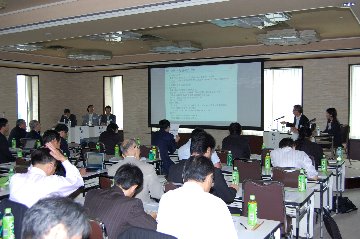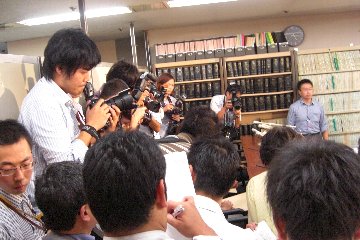|
The registration form
NSK News Bulletin Online
September 2009 -------------------------------------------------------------------
Story of the Month>>> 1st lay-judge trial concludes with all lay judges giving news conference -------------------------------------------------------------------
1st Media-strategy seminar addresses the future of newspapers NSK held its first-ever seminar on media strategy at the Fukoku Forest Square building in Tokyo°«s Uchisaiwai-cho district on Aug. 6, attracting 87 management-planning officials with newspaper companies from all over Japan. °»The Image of Readers/Users in the Media Market in 2015°… served as the topic for an expert panel discussion on the future of newspapers in an Internet era marked by ever-growing reliance on PCs and mobile phones. The four experts on the panel were Risaburo Nezu, managing director and executive fellow at the Fujitsu Research Institute, Kotoba Miki, a senior consultant in the communications & high-tech division of Fujitsu Research Institute, Hiroyoshi Sunakawa, an associate professor at Rikkyo University, and Masahiko Kishira, executive director of the Mobile Marketing Solution Association. Miki of Fujitsu Research described his vision of the future image of the average reader/user of the media, based on a media-use survey conducted in 2008. According to Miki°«s analysis, the average Japanese devotes only 20 percent of his daily media contact to contact with the traditional mass media, including newspapers and TV. However, the same sample consumer devotes 50 percent of his media contact time to non-conventional media, primarily Web sites, which provide information tailored to fit his pastimes and personal tastes. Citing Yahoo°«s °»My Page°… and Google°«s °»News Alert°… as examples, Miki said the general trend is for an increasing number of people to seek out specific information to meet their needs with the least possible effort. Regarding his image of media consumers in 2015, Miki predicted that general behavior would break down into three generations. He said those from the post-war baby boom, who will hit their late 60s by 2015, will tend to remain loyal newspaper readers, as they feel an association with society via the newspaper. °»However, there is a possibility that even they will stop reading newspapers if the present situation, in which news is available for free on the Internet, prevails,°… Miki warned. When it comes to the generation that will be aged around 40 by 2015, they will tend to seek information that fits their personal values, influenced by widening disparities in income levels, Miki predicted. He said the youngest generation, born in 1995 and coming of age around 2015, will generally not be reading newspapers at all. In order for newspaper companies to cope with these changes, Miki proposed the introduction of small digital printing machines to replace conventional large-scale rotary presses. °»Small-size digital printers are capable of accommodating partial changes in editorial content in newspaper pages. Therefore, newspaper publishers would be able to meet the specific needs of individual readers without altering their business formats,°… he suggested. In the panel discussion, the experts also discussed the future prospects for management activities at newspaper companies. Nezu from Fujitsu Research called for a further downsizing and rationalization of the entire newspaper business. °»Newspaper companies should focus on their core business and work out strategies to sustain their core business by taking into account the market size and appropriate prices,°… he said. Specifically, Nezu proposed that newspapers should specialize in °»providing reliable, high-quality information and a point of view to readers,°… adding that printing, personnel affairs and accounting should be outsourced. Sunakawa of Rikkyo University said that, in order for newspapers to squarely compete with the Internet, newspapers need to re-examine their own characteristics and strengths. In order to keep providing high-quality information, he proposed imposing specific deadlines for releasing contents through parallel news Web sites. He warned that frontline reporters are burning out due to the round-the-clock demands resulting from the absence of fixed deadlines for editorial content to be released over the Internet. As for advertising, Nezu suggested that ad sales staff at newspaper companies be reduced as part of downsizing the newspaper business operations, adding that newspapers had little chance of winning a competition against the Internet. However, Kishira of the Mobile Marketing Solution Association said that a drop in advertising revenues for newspapers and magazines could not be wholly offset by an increase in ad revenues on the Internet. Noting that the entire advertising market would shrink unless any countermeasures are taken, Kishira stressed that advertising via mobile media could not stand alone without some collaboration with the traditional mass media.
Panelists speak at NSK°«s first media-strategy seminar in Tokyo on Aug. 6. NTV runs special on false TV report scandal over nonexistent slush fund Nippon Television Network Corp., a major commercial broadcasting station, on Aug. 23 aired a special program explaining its broadcast of a false news report that alleged that a local government had set up and concealed an illegal slush fund. The 30-minute program, aired during the popular NTV news program "Shinso Hodo Bankisha," attributed the false report to negligence in checking the allegation and to a lack of communication between higher-ranking staff and frontline reporters. The program, which aired again in the predawn hours of Aug. 24, also covered the company°«s measures to try to prevent any recurrence of misleading reporting. At the outset of the program, °»How did our false report happen?°… Shintaro Kubo, now an executive adviser with the station, apologized for the scandal. Kubo resigned as NTV president on March 16 to take responsibility for the incident. The program explained how the false report originated with the airing of the uncorroborated testimony of the then head of the news bureau and reporters in charge. As a key error, it said the reporters recklessly trusted an informant and failed to do any background research into his claims. Some staff had raised concerns about the lack of supporting facts, but their worries were not transmitted to the chief producer or to other higher-ranking staff, generating a critical communication gap, the program said. As preventive measures, the company has decided to no longer set any fixed broadcast date for investigative reporting, and to set up a Crisis Management Adviser Team within its news bureau to check all sources and methods of obtaining information. The NTV special came after the Broadcasting Ethics & Program Improvement Organization, an in-house broadcasting regulatory body, concluded on July 30 that the incident constituted a serious violation of broadcast ethics, and called on NTV to air a program explaining the background to its false news report and announcing preventive measures. The entire incident grew out of a Nov. 23, 2008, broadcast of the popular NTV news program "Shinso Hodo Bankisha" which aired a report in which a former construction company executive alleged that the Gifu prefectural government had created a slush fund by using money freed up by placing orders for fictitious construction work. The former executive offered to provide background information through the broadcaster°«s Web site to solicit further information. A prefectural government investigation found no slush fund existed, and later lodged a criminal complaint against the former construction executive. The man eventually admitted that he had lied and NTV aired a formal correction of the report under the terms of the Broadcasting Law. The man was arrested on March 9 of this year on charges of obstructing government operations. On July 23, the Tajimi branch of Gifu District Court found the former construction executive guilty and sentenced him to a suspended three year prison term to be served in the event of any further illegal activities on his part within a parole period of the coming five years.
Book, magazine sales fall below \1 trillion in fiscal 2009 first half The Research Institute for Publications has reported that sales of books and magazines for the April-September period of 2009 were down 4.0 percent from a year ago at \988.7 billion. It is the first time that sales for the first half of a fiscal year have fallen below \1 trillion yen. Sales of magazines in the six-month period marked a year-on-year decline for the 12th consecutive year, and sales of books were down for a third straight year. The combined number of issues of weekly magazines published by newspaper companies plunged 25.2 percent over the same period, due mainly to the discontinuation of the Yomiuri Shimbun°«s weekly magazine, the Yomiuri Weekly, in December 2008. By type of publication, sales of books fell 2.7 percent to \458.1 billion and sales of magazines dropped 5.2 percent to \530.5 billion. Among magazines, sales of monthly publications fell 4.6 percent to \410.5 billion, while sales of weekly magazines dropped 7.1 percent to \120.1 billion. The rate of return of unsold copies was up 0.9 of a percentage point to 39.0 percent for books and up 0.3 of a percentage point to 36.9 percent for magazines. The estimated number of issues of monthly magazines dropped 6.8 percent and that of weekly magazines plummeted 10.1 percent, according to the report. A total of 87 new magazines were launched in the April-September period of this year, or exactly the same number as in the same period one year ago. However, as many as 119 magazines, over 31 more than for the same period in the previous year, either suspended or terminated publication. It was the largest number of suspensions or terminations of magazines in the first half of a fiscal year since 2007, when 104 magazines closed down. Toshiharu Sasaki, chief researcher at the institute, attributed the sharp increase in the closures of magazines to a steep drop in ad revenues since the collapse of Lehman Brothers in the fall of last year, combined with a general trend of declining magazine readership. Pressured by poor sales, the publishers of about 180 magazines resorted to price increases over the same six-month period. As a result, the average price of monthly magazines rose 3.1 percent to \565 and that of weekly magazines climbed 2.8 percent to \325. The report said that while the combined total of actual issues of magazines published dropped 7.9 percent, the year-on-year decline in total sales revenues was buoyed up by the higher average selling price per issue, which limited the revenue decline to a significantly lower 4.8 percent.
|
||||||||||||||

